The steering system of a vehicle converts the rotation of the steering wheel into directional movement of the wheels on the road. When it comes to power steering, it allows the driver, with reduced force on the steering wheel, to turn the vehicle's direction across its entire range. For example, in some passenger vehicles, if this system were not power-assisted, the driver would have to apply about 15 times more force on the steering wheel to navigate the same curved path.
In terms of regulation for passenger vehicles in the European Union, the force required to turn the steering wheel in order to describe a 12m radius circle from the tangent line must not exceed 200N. In the case of a vehicle equipped with power steering, in the event of auxiliary power failure, the vehicle must be able to describe a 20m radius circle and the force must not exceed 300N.

There are various power steering systems. Mechanical steering systems, rack and pinion steering systems, hydraulic power steering systems, including the Servotronic systems and the electro-hydraulic power steering system, electric power steering systems, and even active steering systems, which can be combined with hydraulic power steering systems and electric power steering systems.
The rack and pinion steering system transforms the rotation, applied by the driver, into linear motion transmitted to the wheels. The rotational movement is applied, through the pinion, to the rack, causing it to slide and thus transmit linear motion to the steering bars, which in turn is transmitted to the wheels, allowing the vehicle to change direction.
AdvantagesThe main advantages of using these systems are:
Simple Construction
Low Cost
Good Mechanical Efficiency
Less Space in the Car
Good Steering Response

The hydraulic power steering system relies on hydraulic pressure to multiply the force applied to the steering wheel to the front wheels of the vehicle.
Hydraulic pressure is typically generated by a hydraulic pump driven by the combustion engine through a belt. The pressure provided by the hydraulic pump provides the "force" needed for power steering, and the steering box mechanism regulates the power of the hydraulic fluid. The more force applied to the steering wheel, the higher the pressure of the hydraulic fluid and, consequently, the greater the force applied to the wheels. The steering box mechanism most commonly used in these systems is the rack and pinion.
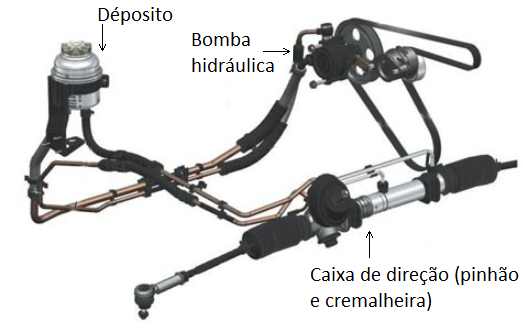
Servotronic is a rack and pinion steering system that varies according to the vehicle's speed and is electronically controlled.
Legend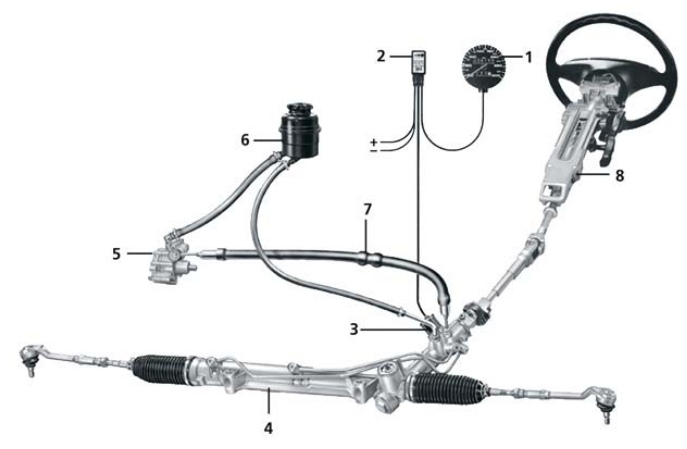
With the use of the electro-hydraulic transducer, the hydraulic feedback effect varies according to speed, and the force to be applied to the steering wheel increases with increasing speed and requires only minimal force at low speeds, for example, in parking or maneuvering situations. This system provides comfortable and safe driving.
ADAS systems use, in addition to the other vehicle sensors, three main types of additional sensors: Radar, Lidar (a sensor similar to radar, but emitting light waves and capturing their reflection), and Camera.
In recent years, manufacturers have turned to electric power steering systems, eliminating hydraulic steering systems from the market. This system has several advantages, such as:
Fuel economy
Oil-free system, hence no risk of contamination
No maintenance required
Enables driving assistance functions, e.g., assisted parking and autonomous driving
Self-diagnosis
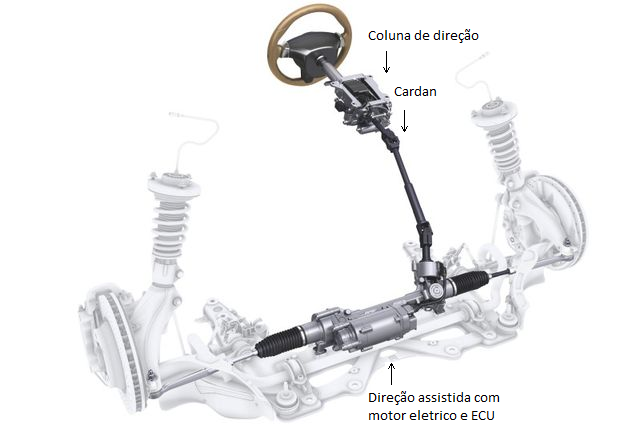
The EPSc system, equipped in low and medium-range vehicles, doesn't take up much space, is lightweight and, in addition to the mechanical components present in previously verified systems, electric assistance is provided through a torque sensor, a helical gear, an electric motor, and a control unit, placed in the steering column.
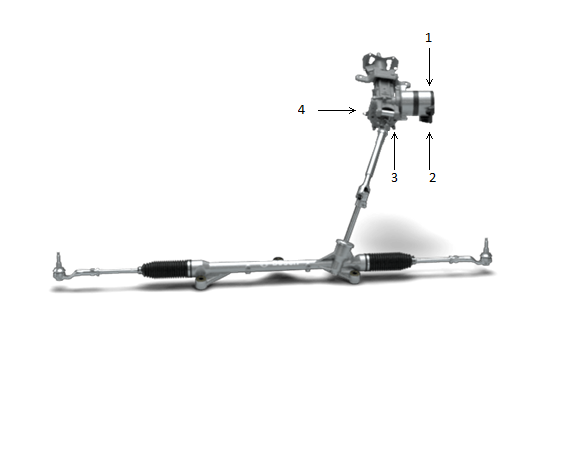
The assembly from the previous figure is integrated into the steering column and connected to the rack and pinion steering through a universal joint. The torque sensor is placed next to the helical gear and, based on the torque information generated by the electric motor, assistance force is transmitted to the steering column through the helical gear.
This system meets the highest standards of safety and reliability without compromising the driving feel and steering feedback.
The EPSdp system, equipped in mid-range vehicles, is a highly versatile, robust, and maintenance-free system. To the rack and pinion mechanical system, a steering pinion and a secondary pinion have been added, which, together with the electric motor, helical gear, electronic control unit, and torque sensor, provide electric assistance.

In this system, torque is transmitted to the belt through a toothed wheel located on the electric motor. The rotational movement of the belt is converted into linear movement in the rack.
This system, like the EPSdp electric steering system, is compatible with driver assistance systems such as assisted parking or autonomous driving and is equipped with redundancy systems that ensure vehicle control and occupant safety in case of main system failure.
The active steering system is a technology designed to vary the steering angle of the front wheels based on the vehicle's speed. The lower the vehicle speed, the greater the increase in the front wheel angle per steering wheel rotation angle. The variation in the wheel angle is done through sensors placed in the steering column, which detect, for each driving situation and driver intention, the necessary action to vary the wheel angle.
If these sensors and the respective electronic control system fail, the clutch placed in the gear system, identified in the previous figure, becomes locked, and the conversion of the steering wheel angle into the corresponding wheel angle is disabled, leaving the vehicle without power steering.
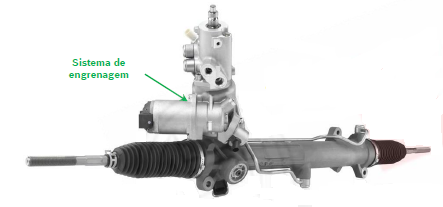
The active steering system is relevant in terms of vehicle safety, as it prevents understeer and oversteer, and it is also relevant in terms of comfort, as it facilitates vehicle steering during maneuvers. For example, in a maneuvering situation, a driver of a passenger car equipped with electro-hydraulic steering technology needs to turn the steering wheel twice as much to reach the limit compared to the same type of vehicle equipped with active steering technology. This system can be combined with the Servotronic electro-hydraulic steering system, used in BMW, and with the EPSc system, used in Audi.













